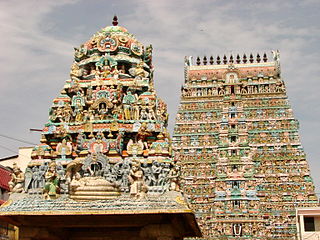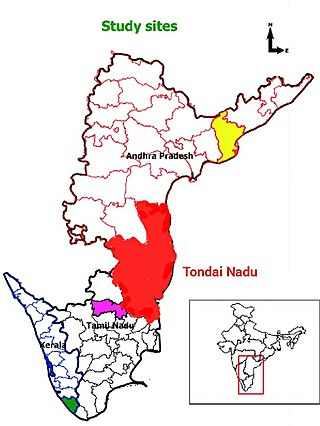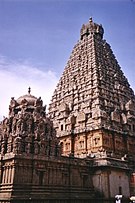
The Carnatic region is the peninsular South Indian region between the Eastern Ghats and the Bay of Bengal, in the erstwhile Madras Presidency and in the modern Indian states of Tamil Nadu and southern coastal Andhra Pradesh. During the British era, demarcation was different and the region included current day Karnataka and the whole region south of the Deccan.

The history of southern India covers a span of over four thousand years during which the region saw the rise and fall of a number of dynasties and empires.

The Pandyan dynasty, also referred to as the Pandyas of Madurai, was an ancient Tamil dynasty of South India, and among the four great kingdoms of Tamilakam, the other three being the Pallavas, the Cholas and the Cheras. Existing since at least the 4th to 3rd centuries BCE, the dynasty passed through two periods of imperial dominance, the 6th to 10th centuries CE, and under the 'Later Pandyas'. Under Jatavarman Sundara Pandyan I and Maravarman Kulasekara Pandyan I, the Pandyas ruled extensive territories including regions of present-day South India and northern Sri Lanka through vassal states subject to Madurai.

Krishnadevaraya was an emperor of the Vijayanagara Empire reigning from 1509 to 1529. He was the third monarch of the Tuluva dynasty, and is considered to be one of the greatest rulers in Indian history. He ruled the largest empire in India after the fall of the Islamic Delhi Sultanate. Presiding over the empire at its zenith, he is regarded as an icon by many Indians. Krishnadevaraya earned the titles Andhra Bhoja, Karnatakaratna Simhasanadeeshwara, Yavana Rajya Pratistapanacharya, Kannada Rajya Rama Ramana, Gaubrahmana Pratipalaka and Mooru Rayara Ganda. He became the dominant ruler of the peninsula by defeating the sultans of Bijapur, Golconda, the Bahmani Sultanate and the Gajapatis of Odisha, and was one of the most powerful Hindu rulers in India.

Pandya Nadu or Pandi Nadu is a geographical region comprising the southern part of the present day state of Tamil Nadu. The region is bounded on its West by the Venad/Ay Nadu, Northeast by the Chola Nadu and Northwest by the Kongu Nadu. It comprises the present-day districts of Madurai, Theni, Sivaganga, Ramanathapuram, Virudhunagar, Tirunelveli, Tenkasi, Thoothukudi, Kanniyakumari, parts of Pudukkottai and Dindigul.
The Reddi kingdom or Kondavidu Reddi kingdom was established in southern India by Prolaya Vema Reddi. Most of the region that was ruled by the Reddi dynasty is now part of modern-day coastal and central Andhra Pradesh. They helped the Bahmani Sultanate and defeated the Vijayanagar empire in the War of the Goldsmith's Daughter.
Nayaka dynasties emerged during the Kakatiya dynasty and the Vijayanagara Empire period. The Nayakas were originally military governors under the Vijayanagara Empire. After the battle of Talikota, several of them declared themselves independent.
Pemmasani Nayaks were a ruling clan in the south Indian state of Andhra Pradesh. They came into prominence during Vijayanagara Empire. After the Battle of Talikota in 1565 AD, the collapse of Vijayanagara Empire led to the emergence of Pemmasani Nayakas in the Rayalaseema region. They belonged to the Kamma social group.
Tuluva Narasa Nayaka was an Indian general and later an Imperial Regent who founded the Tuluva dynasty of the Vijayanagara Empire. He was the father of the Emperors Viranarasimha Raya, Krishnadevaraya and Achyuta Deva Raya.

Vellore Fort is a large 16th-century fort situated in heart of the Vellore city, in the state of Tamil Nadu, India built by the Emperors of Vijayanagara. The fort was at one time the imperial capital of the Aravidu Dynasty of the Vijayanagara Empire. The fort is known for its grand ramparts, wide moat and robust masonry.
The Gajapati Empire, was an empire established by the Suryavamsa dynasty or Routray dynasty, who were a medieval Hindu dynasty in the Indian subcontinent. It originated in the region of Trikalinga and reigned from 1434 to 1541 CE. It succeeded the reign of the Eastern Gangas. Under the Emperor Kapilendra Deva, the Gajapati empire stretched from lower Ganga in the north to Kaveri in the south.
Sriranga II was nominated in 1614 by Emperor Venkata II to succeed him as the Emperor of Vijayanagara. Sriranga was supported by a faction headed by Yachama Nayaka of Recherla Velama dynasty, one of the Venkata II's loyal viceroys and commanders and Nayak of Venkatagiri, but was not favored by a set of nobles headed by Gobburi Jagga Raya, brother of Venkata II's favourite Queen Obayamma.
Sriranga III was the last ruler of the Vijayanagara Empire, who came to power in 1642 following the death of his uncle Venkata III. He was also a great grandson of Aliya Rama Raya.

Venkatapati Raya was the third Emperor of Vijayanagara from the Aravidu Dynasty. He succeeded his older brother, the Emperor Sriranga Deva Raya as the ruler of Vijayanagara Empire with bases in Penukonda, Chandragiri and Vellore. His reign of nearly three decades saw a revival in the strength and prosperity of the empire. He successfully dealt with the Turko-Persian Deccan sultans of Bijapur and Golkonda, the internal disorders, promoting economic revival in the realm. He subdued the rebelling Nayakas of Tamil Nadu and parts of present-day Andhra Pradesh.

The recorded history of Andhra Pradesh, one of the 28 states of 21st-century India, begins in the Vedic period. It is mentioned in Sanskrit epics such as the Aitareya Brahmana. Its sixth-century BCE incarnation Assaka lay between the Godavari and Krishna Rivers, one of sixteen mahajanapadas. The Satavahanas succeeded them, built Amaravati, and reached a zenith under Gautamiputra Satakarni.

The Nayaks of Gingee (Senji) were Telugu rulers of the Gingee principality of Tamil Nadu between 16th to 18th century CE. The Gingee Nayaks had their origins in the Balija warrior clans of present-day Andhra Pradesh. They were subordinates of the imperial Vijayanagara emperors, and were appointed as provincial governors by the Vijayanagar Emperor who divided the Tamil country into three Nayakships viz., Madurai, Tanjore and Gingee. Later, after the fall of the Vijayanagara's Tuluva dynasty, the Gingee rulers declared independence. While they ruled independently, they were sometimes at war with the Tanjore neighbors and the Vijayanagara overlords later based in Vellore and Chandragiri.

Tamil Nadu is known for its ancient temple architecture. Nearly 33,000 ancient temples, many at least 800 to 2000 years old, are found scattered all over Tamil Nadu. As per Tamil Nadu Hindu Endowments Board, there are 38,615 temples. Most of the largest Hindu Temples reside here. Studded with complex architecture, a variety of sculptures, and rich inscriptions, the temples remain the very essence of the culture and heritage of Tamil land, with historical records dating back to at least 3,000 years.

Tondaimandalam, also known as Tondai Nadu, is a historical region located in the northernmost part of Tamil Nadu and southernmost part of Andhra Pradesh. The region comprises the districts which formed a part of the legendary kingdom of Athondai Chakravarti. The boundaries of Tondaimandalam are ambiguous – between the river basins of Penna River and Ponnaiyar River. During the reign of Rajaraja I, this region was called as Jayankonda Cholamandalam.
Kumara Krishnappa Nayak was a ruler of the Madurai Nayak dynasty. He was the successor of King Vishwanatha Nayak. He started ruling the country after his father's death in 1564. He made Tiruchirapalli as his capital.

The Bhoi dynasty or the Yaduvamsa dynasty were a medieval Hindu dynasty from the Indian subcontinent, which originated in the region of Odisha that reigned from 1541 to 1560 CE. Govinda Vidyadhara had usurped the throne from the later weaker Suryavamsa Gajapati Empire rulers as the kingdom started weakening but had a short-lived reign as ruling chiefs of Odisha as the ensuing internal rivalries and constant threats of invasions rendered them weak and were eventually overthrown by Mukunda Deva of Chalukya dynasty in 1560.













